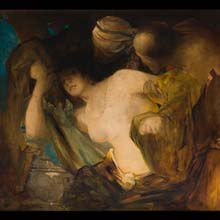
material: oil on canvas
dimensions: 92 × 100 cm
description: A biblical story about the beautiful and virtuous Susanna, the wife of Joakim, falsely accused of adultery by rejected suitors, is one of the most frequently illustrated fragments of the Old Testament. The decisive factor in the popularity of the motif was not so much its moral and didactic nature, teaching about the inevitability of punishment for making false accusations and for the violation of the imperatives contained in the Ten Commandments, or its religious values reflecting God’s justice, but its erotic character. It is one of the biblical scenes which provided a sublime excuse for showing the beauty of the female body and the male lust, the excitement of sexual perversion, expressed here in an attempt to get the “forbidden fruit,” the difference of age, the numerical superiority of the would-be lovers and their cruel revenge for the insult of being rejected. Susanna and two elders secretly observing her as she baths and persuading her to have sex with them is the subject of paintings by such masters of European painting as Tintoretto, Rubens or Rembrandt. The painting by Żmurko, an artist specializing in painting over-stylized female portraits as well as nudes sometimes rendered in the Oriental, harem context, clearly emphasizes the erotic nature of the scene. The woman’s body, portrayed in big close-up, expressively moved, has been highlighted with the light in contrast with the elders who are almost invisible in the shadow. A seemingly clear message about the innocence which is not afraid of light or the sin that tends to lurk in the shadow serves a completely different purpose. One can get the impression that the almost indiscernible voyeurs personify the woman’s own sinful thoughts. Susanna’s pose, explained by her attempt to dodge the attackers, and her hands raised in a gesture of defence give her charm and even some lecherousness. The value of the painting lies in an unconventional use of implied meanings through an interesting composition and painterly solutions within a reduced, toned-down palette as well as an atmosphere of mystery and ambiguity, anticipating the symbolism of the end of the century. Wacława Milewska
exposition: The Gallery of 19th Century Polish Art in Sukiennice,
The Cloth Hall, 1, Main Market Square
key: Around the academy >>>
dimensions: 92 × 100 cm
description: A biblical story about the beautiful and virtuous Susanna, the wife of Joakim, falsely accused of adultery by rejected suitors, is one of the most frequently illustrated fragments of the Old Testament. The decisive factor in the popularity of the motif was not so much its moral and didactic nature, teaching about the inevitability of punishment for making false accusations and for the violation of the imperatives contained in the Ten Commandments, or its religious values reflecting God’s justice, but its erotic character. It is one of the biblical scenes which provided a sublime excuse for showing the beauty of the female body and the male lust, the excitement of sexual perversion, expressed here in an attempt to get the “forbidden fruit,” the difference of age, the numerical superiority of the would-be lovers and their cruel revenge for the insult of being rejected. Susanna and two elders secretly observing her as she baths and persuading her to have sex with them is the subject of paintings by such masters of European painting as Tintoretto, Rubens or Rembrandt. The painting by Żmurko, an artist specializing in painting over-stylized female portraits as well as nudes sometimes rendered in the Oriental, harem context, clearly emphasizes the erotic nature of the scene. The woman’s body, portrayed in big close-up, expressively moved, has been highlighted with the light in contrast with the elders who are almost invisible in the shadow. A seemingly clear message about the innocence which is not afraid of light or the sin that tends to lurk in the shadow serves a completely different purpose. One can get the impression that the almost indiscernible voyeurs personify the woman’s own sinful thoughts. Susanna’s pose, explained by her attempt to dodge the attackers, and her hands raised in a gesture of defence give her charm and even some lecherousness. The value of the painting lies in an unconventional use of implied meanings through an interesting composition and painterly solutions within a reduced, toned-down palette as well as an atmosphere of mystery and ambiguity, anticipating the symbolism of the end of the century. Wacława Milewska
exposition: The Gallery of 19th Century Polish Art in Sukiennice,
The Cloth Hall, 1, Main Market Square
key: Around the academy >>>












